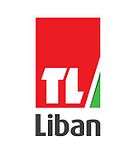Télé Liban
Télé Liban (TL) (Arabic: تلفزيون لبنان) is the first Lebanese public television network, owned by the Lebanese government. TL is the current Lebanese member of the European Broadcasting Union (EBU).[1]
 | |
| Type | Terrestrial & satellite television network |
|---|---|
| Country | |
| Availability | Lebanon Arab World European Union Australia Canada United States |
| Founded | 1959 |
| Owner | Lebanese Public (Governmental corporation) |
Official website | Official website |
History
The Lebanese government granted businessmen Wissam Izzeddine and Alex Moufarrej the first local television license in August 1956, and Compagnie libanaise de Télévision-CLT, which would later be changed to Télé Liban, aired programs for the first time on May 28, 1959, making it the first TV station not only in Lebanon but also in the region.[2] The station was officially launched by General Sleiman Nawfal with the aid of France.[1][3] The station remained Lebanon's only television station until Télé-Orient obtained its own license in July 1961[4] and began operating from Hazmieh.[5]
The Golden Age
Throughout the 1960s and until the 1970s, Télé Liban provided local, original programming as well as imports from France and the United States.[6] What made Télé Liban unique in the region was its creation of innovative content for a pluralistic country like Lebanon.[7]
During the Civil War
During the war, the two private television stations had been taken over by militias, and the newly elected president, Elias Sarkis wanted a unified media outlet to promote his agenda of peace and unity.[8] The two privately owned stations, CLT and Télé Orient, and their subsidiaries agreed to merge in a deal where half the shares were owned by the Lebanese government[9] . The Legislative Decree No. 100 was published in the national gazette on July 7, 1977, making the merger official[10]
Post-War Period
When the civil war ended, Télé Liban's monopoly was removed under the 1994 Audiovisual Media Law, and the station found itself for the first time facing tremendous competition.[11] Other television stations with more innovative programming, such as the Lebanese Broadcasting Corporation International, overtook Télé Liban's audience in the 1990s.[12]
Rafic Hariri bought the private sector shares of Télé Liban months before he became prime minister in 1992 and appointed Fouad Naïm as chairman, who quickly revamped the station.[13] However, the government bought back all the shares from the private sector in 1994.[14]
The plethora of private terrestrial and satellite stations available in the Lebanese television market came at the expense of Télé Liban, which since the late 1990s been in continuous decline[15] .
Administration
Initially, Télé Liban was managed by a board composed of twelve directors, six representing the government and six representing TLC and Télé Orient.[16]
The chair of the channel is appointed by the Lebanese cabinet. Jean Claude Boulos and Ibrahim Khoury were former presidents of the channel during the 1990s.[17] As of 2014 Talal Makdessi is the president of the channel.[3]
Availability
As of 2012, Télé Liban became available for viewers in North and South America through over-the-top technology on myTV.[18]
References
- "Tele Liban". Tele Liban. Retrieved 22 October 2012.
- "Télé Liban looks to continue a long, prestigious history". Annahar. Retrieved 22 May 2018.
- "Lebanese media coverage of oil and gas sector" (PDF). SKeyes. August 2014. Retrieved 16 September 2014.
- "Télé Liban looks to continue a long, prestigious history". Annahar. Retrieved 22 May 2018.
- Harb, Zahera. Channels of Resistance in Lebanon: Liberation Propaganda, Hezbollah and the Media, I.B.Tauris (April 15, 2011), page 98
- Kraidy. Marwan M.Hybridity, or the Cultural Logic of Globalization, Pearson Longman, Temple University, 2005, page 123
- Kraidy. Marwan M.Hybridity, or the Cultural Logic of Globalization, Pearson Longman, Temple University, 2005, page 123
- Harb, Zahera. Channels of Resistance in Lebanon: Liberation Propaganda, Hezbollah and the Media, I.B.Tauris (April 15, 2011), page 97
- Harb, Zahera. Channel of Resistance in Lebanon: Liberation Propaganda, page 97
- Harb, Zahera. Channels of Resistance in Lebanon: Liberation Propaganda, Hezbollah and the Media, I.B.Tauris (April 15, 2011), page 97
- Sakr, Naomi. Arab Television Today, I. B. Tauris & Co. Ltd., London 2007, page 34
- Rugh, William A. Arab Mass Media: Newspapers, Radio, and Television in Arab Politics, Praeger Publishers, Westpport, CT, 2004, page 203
- Harb, Zahera. Channels of Resistance in Lebanon: Liberation Propaganda, Hezbollah and the Media, I.B.Tauris (April 15, 2011), page 102
- Harb, Zahera. Channels of Resistance in Lebanon: Liberation Propaganda, Hezbollah and the Media, I.B.Tauris (April 15, 2011), page 103
- Kraidy. Marwan M.Hybridity, or the Cultural Logic of Globalization, Pearson Longman, Temple University, 2005, page 123
- Harb, Zahera. Channels of Resistance in Lebanon: Liberation Propaganda, Hezbollah and the Media, I.B.Tauris (April 15, 2011), page 97
- "Lahoud implores Tele-Liban to prioritize satellite broadcasting". The Daily Star. 30 April 1999. Retrieved 22 October 2012.
- Channels List Archived 28 June 2012 at the Wayback Machine My TV.